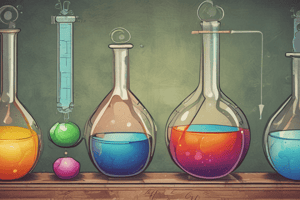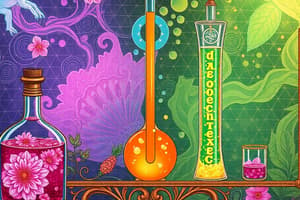Podcast
Questions and Answers
A substance with a pH in the range of 0-6 is an example of what?
A substance with a pH in the range of 0-6 is an example of what?
- Neutral solutions
- Salts
- Acids (correct)
- Bases
A substance with a pH in the range of 8-14 is an example of what?
A substance with a pH in the range of 8-14 is an example of what?
- Neutral solutions
- Salts
- Acids
- Bases (correct)
In water, acids form what?
In water, acids form what?
Hydrogen ions
In water, bases form what?
In water, bases form what?
What is the difference between a strong acid and a weak acid?
What is the difference between a strong acid and a weak acid?
What is the difference between a strong base and a weak base?
What is the difference between a strong base and a weak base?
Which solution has a greater concentration of hydrogen ions, pH 3 or pH 7?
Which solution has a greater concentration of hydrogen ions, pH 3 or pH 7?
What are the products formed when a base reacts with an acid?
What are the products formed when a base reacts with an acid?
What is the pH of a neutral solution?
What is the pH of a neutral solution?
What is a hydroxide ion?
What is a hydroxide ion?
What is the pH scale?
What is the pH scale?
What is acid rain?
What is acid rain?
What is neutralization?
What is neutralization?
What is salt?
What is salt?
What does an acid taste like?
What does an acid taste like?
What does a base taste like?
What does a base taste like?
What color does an acid turn litmus paper?
What color does an acid turn litmus paper?
What color does a base turn litmus paper?
What color does a base turn litmus paper?
How does an acid react with carbonates?
How does an acid react with carbonates?
How does a base react with carbonates?
How does a base react with carbonates?
How does an acid react with the metals magnesium, zinc, and iron?
How does an acid react with the metals magnesium, zinc, and iron?
How does a base react with the metals magnesium, zinc, and iron?
How does a base react with the metals magnesium, zinc, and iron?
What does corrosive mean?
What does corrosive mean?
If a substance reacts with a metal to produce hydrogen gas, what can you infer about the substance?
If a substance reacts with a metal to produce hydrogen gas, what can you infer about the substance?
What is an indicator?
What is an indicator?
Why are bases often described as the opposites of acids?
Why are bases often described as the opposites of acids?
Flashcards are hidden until you start studying
Study Notes
Acids and Bases Overview
- Acids are substances with a pH between 0 and 6, indicating higher hydrogen ion concentration.
- Bases are substances with a pH from 8 to 14, indicating higher hydroxide ion concentration.
- A neutral solution has a pH of 7.
Ion Formation in Water
- Acids dissociate in water to produce hydrogen ions (H+).
- Bases dissociate in water to produce hydroxide ions (OH-).
Strength of Acids and Bases
- Strong acids completely dissociate into ions in a solution, while weak acids partly dissociate.
- Strong bases fully dissociate into ions, whereas weak bases only partially dissociate.
Hydrogen Ion Concentration
- A solution with a pH of 3 has a greater concentration of hydrogen ions compared to a solution with a pH of 7.
Neutralization and Products
- The reaction between an acid and a base results in the formation of water and salt.
Chemical Reactions and Indicators
- Acid rain results from atmospheric pollutants and is harmful to the environment.
- Foods and taste perception:
- Acids typically have a sour taste.
- Bases usually have a bitter taste.
- In litmus tests:
- Acids turn litmus paper red.
- Bases turn litmus paper blue.
Reactivity with Carbonates and Metals
- Acids react with carbonates to produce carbon dioxide gas.
- Bases generally do not react with carbonates.
- Acids react with metals (e.g., magnesium, zinc, iron) producing hydrogen gas and are corrosive.
- Bases do not generally react with these metals.
Corrosivity and Classification
- Corrosive substances can wear away materials over time.
- Substances that react with metals to generate hydrogen gas are classified as acids.
- Indicators are substances that change color in the presence of acids or bases.
Bases vs. Acids
- Bases are considered "opposites" of acids due to contrasting tastes, effects on litmus paper, and reactivity with metals and carbonates.
Studying That Suits You
Use AI to generate personalized quizzes and flashcards to suit your learning preferences.




